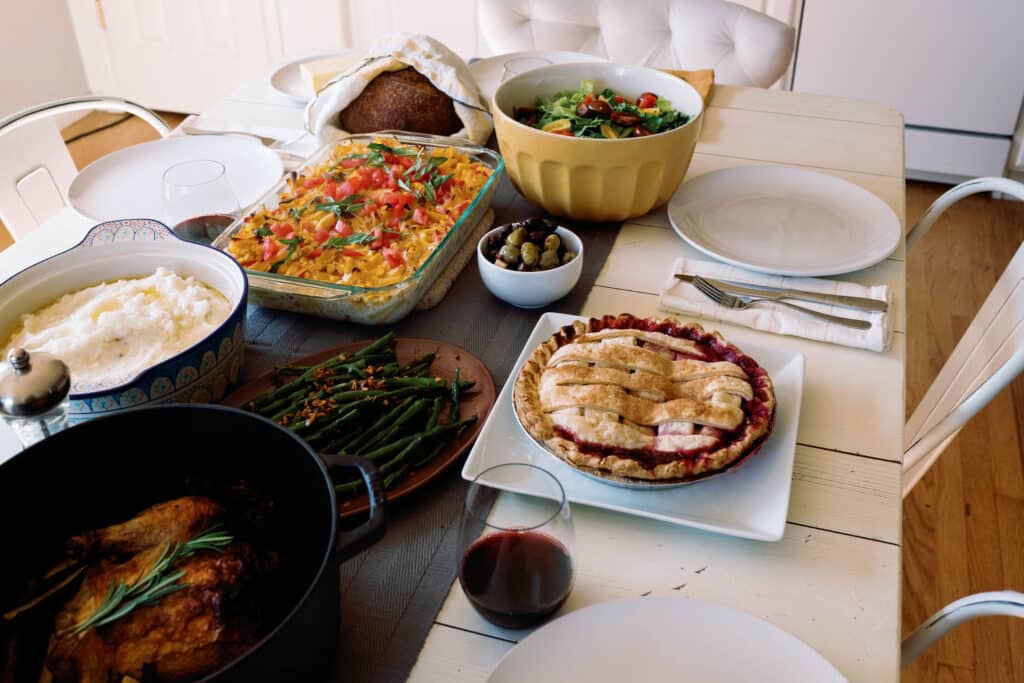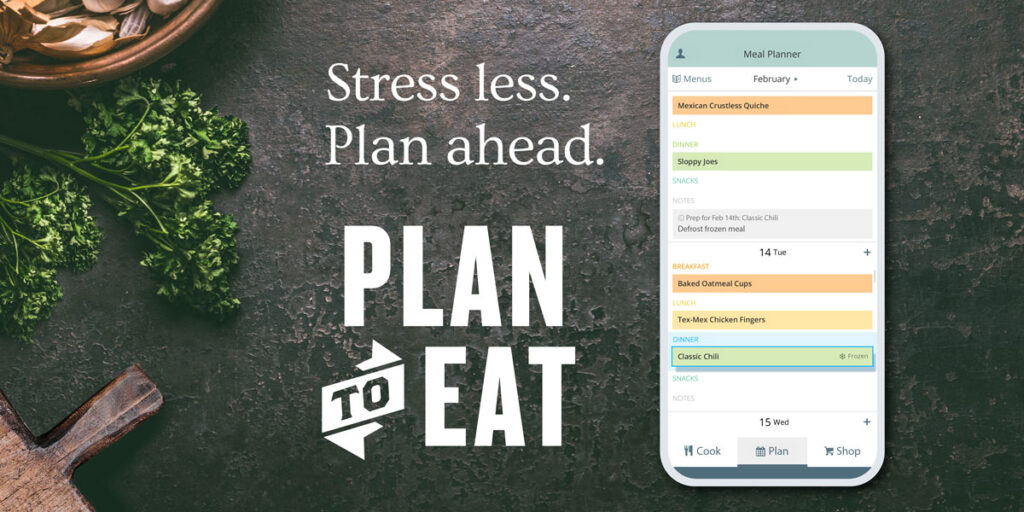The previous installment of our How to Meal Plan Series focused on planning for a small household, serving one or two people. Today, we’re flipping the script and looking at how to simplify meal planning for a large household. The biggest challenges of feeding a large family are buying enough groceries, pleasing everyone (especially if you have picky eaters or food allergies to contend with), and having an answer to the ever present question, “what’s for dinner?”.
The challenges large households face on a weekly basis are also ones that smaller households face during the holiday season with guests and extra mouths to feed. Let’s see how one Plan to Eat customer handles meal planning for a large household and what features of Plan to Eat help her make it possible!

How it’s done:
Below is how a Plan to Eat customer, Betty, plans for her large family:
We have had up to 9 people living in our home at one time, so meal planning is a big deal. I usually sit down with my computer and a favorite drink to menu plan. I have tried to plan for longer than a week, but I have found that if I don’t tailor my menu plans to my schedule, I’m not successful at utilizing them. And my horizon for knowing my schedule in enough detail is about a week.
I start my menu week on Fridays because that’s when I do my big shopping run. I shop then because I want fresh weekend meat and produce for having family/friends over. So I have my menu week and shopping range in Plan to Eat set for Friday to Thursday.
I look at my calendar and see if we have something that will impact dinner prep time or dinner time and enter that as a dinner note in Plan to Eat. A soccer game? A school event? If so I try to plan a dinner the night before that will yield leftovers or plan something in the slow cooker.
Next I look at what I already have that I can or need to use up. Spinach going wilty that I could use in a soup? Tomatoes that are super ripe and would be great in sandwiches? I schedule those meals in and plan to use them in the next day or so, adding in anything extra I need from the store.
Next I ask the kids for suggestions of favorites or things they are craving and try to incorporate one or two that week.
I try to schedule the things with the most delicate produce early in my menu week and save the things that use more pantry staples for later in the week. Then if we end up super busy or have more leftovers from something early in the week, I don’t have food waste.
Then I print out my Plan to Eat shopping list and head to the store. I also print out my Plan to Eat menu plan and recipes for the week and keep them on a clipboard that hangs next to my stove.
I have loved that Plan to Eat has allowed flexibility in scaling recipes to fit the number of family members we are feeding at a given time and also flexibility in the recipes we use. Since starting to use Plan to Eat, we have stopped eating meat, dairy, and eggs, so our cooking has changed. But we are still able to use the same amazing tool!
Betty has great meal planning tips for a large family and I love that she’s self-aware enough to realize she can only successfully plan ahead one week at a time! She mentions planning leftovers to accommodate a busy schedule and asking family members for recipe suggestions, which are both great ways to simplify planning for a lot of people. Leftovers or crockpot meals take the stress off cooking for a group of people on a night when you don’t have time. And asking for recipe ideas helps family members get excited about what’s coming for dinner. You may not be able to accommodate everyone’s requested meal each week, but like Betty, you can include one or two.
Her planning and shopping schedule is also centered around the days they expect to feed the most people. If the number of people in your household fluctuates during the week this is a good way to make sure you’re stocked up on what you need, when you need it most.
What stands out to me about Betty’s process is the focus on fresh food and eliminating food waste. Even with a large family, if you over plan or over shop, you’re going to end up with wasted food. Not only does Betty look to see what can be used up in her fridge, but she also strategically plans her recipes so that fresh ingredients get used up earlier in the week. This is a great tactic for preventing delicate, easy to spoil produce from going bad before you have a chance to use it.

How Plan to Eat can help:
When it comes to having a busy schedule and also feeling a large household, scaling recipes and planning leftovers will remove the burden of cooking every night. In Plan to Eat, you can adjust the servings of your recipes and the ingredients will automatically adjust, so you buy the right quantities of ingredients. If you’re expecting more guests on a certain day, you can scale recipes on your Planner to change quantities for that once meal.
If you doubled or tripled your recipe to accommodate leftovers, you can create leftover notes on the Planner to remind yourself (and everyone else) to eat the extra food you prepared for your busier nights.
On the Plan to Eat website, you can also update your Planner dates so your planning week starts on whatever day works best for you. Betty has hers set to Fridays, since she strategically plans her week starting that day.
Finally, if you are dealing with food allergies or restrictions for a family member or a guest, utilizing Tags on your recipes can help you find allergen-friendly meals faster. And you can use the Without Ingredients search on the website to show recipes that don’t contain certain ingredients at all.
Meal planning is essential when you’re feeding a lot of people to ensure you buy enough food, reduce food waste, and work around busy schedules. Plus, you’ll find you’re less stressed about food and having an answer to the question, “what’s for dinner?”.
P.S. You can find the other posts in the How to Meal Plan Series on the Plan to Eat blog.






